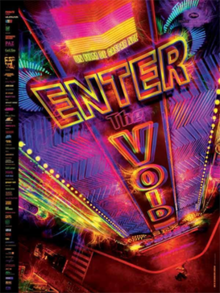| Enter the Void | |
|---|---|
 Theatrical release poster | |
| Directed by | Gaspar Noé |
| Written by |
|
| Produced by |
|
| Starring |
|
| Cinematography | Benoît Debie |
| Edited by |
|
Production companies |
|
| Distributed by | |
Release dates |
|
Running time | |
| Countries | |
| Language | English |
| Budget | €12.4 million |
| Box office | $1.5 million[7] |
Enter the Void is a 2009 English-language art film[8] written and directed by Gaspar Noé and starring Nathaniel Brown, Paz de la Huerta, and Cyril Roy. A fantasy psychological drama set in the neon-lit nightclub environments of Tokyo, the story follows Oscar, a young American drug dealer who gets fatally shot by the police, but continues to watch subsequent events during an out-of-body experience. The film is shot from a first-person viewpoint, which often floats above the city streets, and occasionally features Oscar staring over his own shoulder as he recalls moments from his past. Noé labels the film a "psychedelic melodrama".[9]
Noé's dream project for many years, the production was made possible after the commercial success of his earlier feature film Irréversible (2002). Enter the Void was primarily financed by Wild Bunch, while Fidélité Films led the actual production. With a mix of professionals and newcomers, the film makes heavy use of imagery inspired by experimental cinema and psychedelic drug experiences. Principal photography took place on location in Tokyo, and involved many complicated crane shots. Co-producers included the visual effects studio BUF Compagnie, which also provided the computer-generated imagery. The film's soundtrack is a collage of electronic pop and experimental music.
A rough cut premiered at the 2009 Cannes Film Festival, but post-production work continued, and the film was not released in France until almost a year later. A cut-down version was released in the United States and United Kingdom in September 2010. The critical response was sharply divided: positive reviews described the film as captivating and innovative, while negative reviews called it tedious and puerile. The film performed poorly at the box office.
- ^ "Enter the Void". Cineuropa. Retrieved 1 August 2020.
- ^ a b "Enter the Void". Lumiere. Retrieved 1 August 2020.
- ^ "Enter the Void (18)". British Board of Film Classification. 2 August 2010. Retrieved 7 December 2015.
- ^ "Enter the Void (18)". British Board of Film Classification. 12 August 2010. Retrieved 7 December 2015.
- ^ "Enter the Void". Filmportal.de (in German). Retrieved 19 January 2019.
- ^ "Enter the Void". UniFrance. Retrieved 19 January 2019.
- ^ "Enter the Void (2010)". The Numbers. Retrieved 23 July 2016.
- ^ Ebiri, Bilge (27 January 2010). "Sundance: Gaspar Noe On Enter the Void, Avatar, and Magic Mushrooms". Vulture. Archived from the original on 16 January 2019. Retrieved 15 January 2019.
Sort of an art-film counterpart to Cameron's film, Void is a fever dream that blends elements of 2001, The Tibetan Book of the Dead, and dozens of other films, books, and videogames to craft a journey into an alternate reality, one that seems to have emerged from the deepest recesses of one passionately twisted auteur's mind.
- ^ Cite error: The named reference
presskit interviewwas invoked but never defined (see the help page).